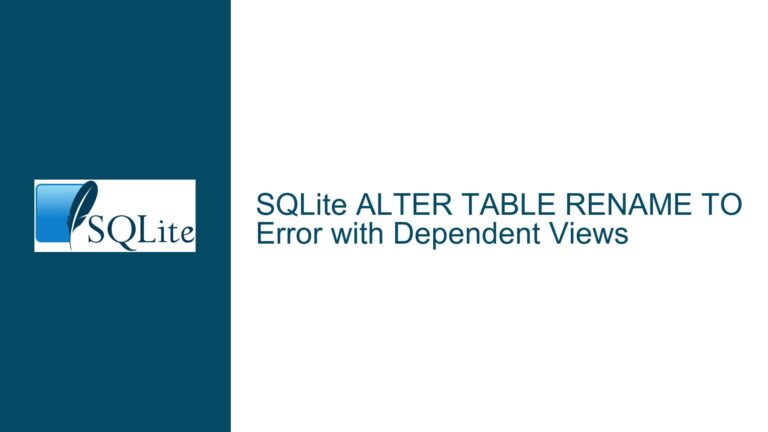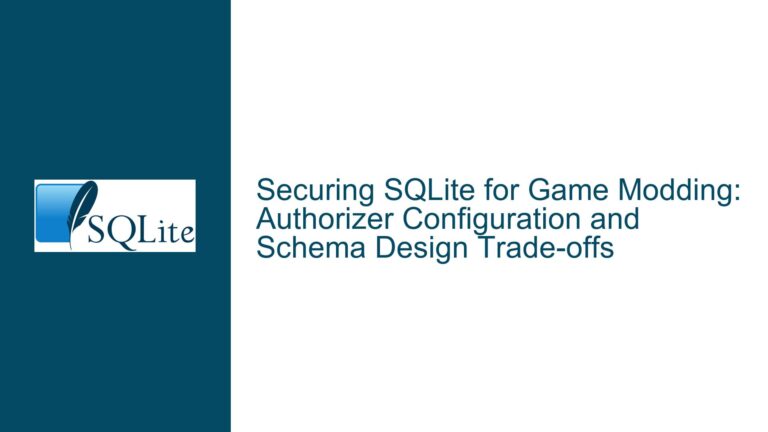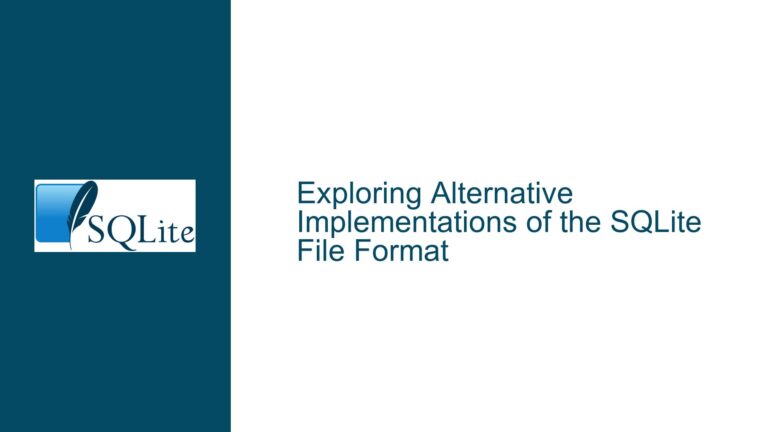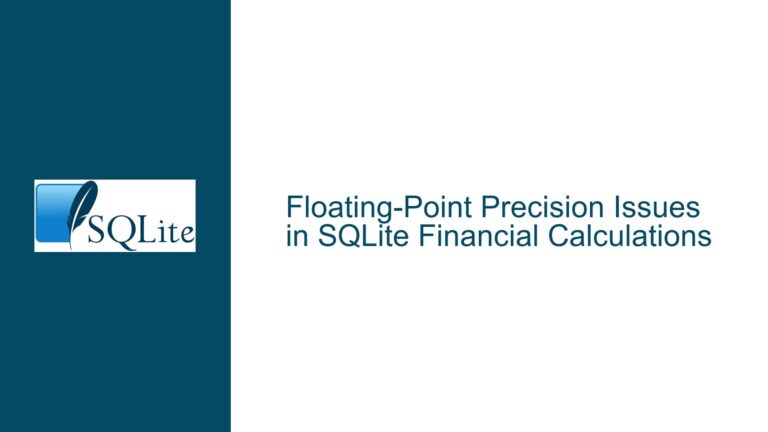Using Variables for Table and Column Names in SQLite: Dynamic SQL and Schema Design
Issue Overview: Parameter Binding Limitations and Schema Design Flaws
The core challenge revolves around attempting to use bound parameters (the ? placeholder syntax) for SQLite identifiers (table names and column names) in C code. SQLite’s API enforces a strict separation between identifiers (structural elements of the database schema) and values (data stored within the schema). Bound parameters are exclusively designed for substituting values into a pre-compiled SQL statement. Identifiers must be known at the time the SQL statement is prepared (compiled) by sqlite3_prepare_v2(), as they define the structure of the query. Attempting to bind a table name via sqlite3_bind_text() will fail because the placeholder ? in CREATE TABLE ? (...) is invalid syntax for an identifier. This results in error codes such as SQLITE_ERROR or SQLITE_MISUSE.
A secondary issue stems from the database schema design. The original approach involves creating separate tables for each directory (e.g., dir1, dir2), with columns dynamically named after files (e.g., file1, file2). This violates fundamental principles of relational database normalization. It leads to a proliferation of tables with identical structures, complicates querying across directories, and creates maintenance overhead. The correct approach is to use a single table with additional columns to represent the variable components (directory paths and filenames) as data rather than schema elements.
Possible Causes: Misunderstanding SQL Syntax and Lack of Normalization
Misapplication of Bound Parameters for Identifiers
SQLite’s parameter binding mechanism (?,:var,@var) is strictly for value substitution. Identifiers (table names, column names) cannot be parameterized because they define the query’s structure. The SQL parser requires identifiers to be static during the preparation phase. For example, the statementCREATE TABLE ? (id INTEGER);is syntactically invalid because the parser expects a literal identifier afterCREATE TABLE, not a placeholder.Dynamic Schema Generation Without Proper Sanitization
Dynamically generating table or column names from user-supplied variables introduces risks of SQL injection if not handled properly. While constructing SQL statements via string formatting (e.g.,snprintf) is possible, it requires rigorous validation and escaping of identifiers usingsqlite3_mprintf("%w", identifier)to prevent malicious input from altering the query structure.Unnormalized Database Schema
Creating separate tables for each directory or column for each file indicates a lack of normalization. This design forces the application to manage an unpredictable number of tables, complicates data retrieval (e.g., aggregating files across directories), and violates the First Normal Form (1NF), which requires atomicity of data and avoidance of repeating groups. A normalized schema would store directories and files as rows in fixed tables, using foreign keys to establish relationships.
Troubleshooting Steps, Solutions & Fixes: Dynamic SQL and Schema Normalization
Step 1: Construct Dynamic SQL Statements Safely
To dynamically create tables or columns with variable names, build the SQL statement as a string using formatted output functions. Always sanitize identifiers to prevent SQL injection.
Example in C:
const char* table_name = "dir1";
char* sql = sqlite3_mprintf(
"DROP TABLE IF EXISTS %w;"
"CREATE TABLE %w ("
"ID INTEGER PRIMARY KEY AUTOINCREMENT,"
"test TEXT NOT NULL);",
table_name, table_name
);
rc = sqlite3_exec(db, sql, NULL, 0, &zErrMsg);
sqlite3_free(sql);
sqlite3_mprintf("%w", ...): Escapes identifiers by enclosing them in double quotes and handling embedded quotes.- Avoid
sprintf/snprintf: Use SQLite’s formatting functions for proper escaping.
Step 2: Normalize the Database Schema
Replace dynamic table creation with a fixed schema that stores variable components as data. For the directory/file example:
Schema:
CREATE TABLE Directories (
directory_id INTEGER PRIMARY KEY,
path TEXT NOT NULL UNIQUE
);
CREATE TABLE Files (
file_id INTEGER PRIMARY KEY,
directory_id INTEGER NOT NULL,
filename TEXT NOT NULL,
FOREIGN KEY (directory_id) REFERENCES Directories(directory_id)
);
Insertion Logic:
- Insert directory path into
Directories, retrieving the auto-incrementeddirectory_id. - Insert filenames into
Fileswith the correspondingdirectory_id.
This eliminates the need for dynamic DDL (Data Definition Language) statements. Queries can now use joins to retrieve files for any directory:
SELECT path, filename
FROM Directories
JOIN Files USING (directory_id)
WHERE path = '/home/user/docs';
Step 3: Refactor Application Logic to Use Normalized Schema
Modify the C code to interact with the fixed schema. Example workflow:
Insert Directory:
const char* path = "/home/user/docs"; sqlite3_exec(db, "INSERT OR IGNORE INTO Directories (path) VALUES (?);", path); // Retrieve directory_id using sqlite3_last_insert_rowid()Insert Files:
int directory_id = ...; // From previous step const char* filename = "report.pdf"; sqlite3_stmt* stmt; sqlite3_prepare_v2(db, "INSERT INTO Files (directory_id, filename) VALUES (?, ?);", -1, &stmt, NULL); sqlite3_bind_int(stmt, 1, directory_id); sqlite3_bind_text(stmt, 2, filename, -1, SQLITE_STATIC); sqlite3_step(stmt);
Step 4: Handle Dynamic Columns via Entity-Attribute-Value (EAV) Model (If Absolutely Necessary)
If columns must be dynamic (e.g., user-defined fields), use an EAV pattern cautiously:
Schema:
CREATE TABLE CustomAttributes (
entity_id INTEGER,
attribute_name TEXT,
attribute_value TEXT,
PRIMARY KEY (entity_id, attribute_name)
);
Querying EAV Data:
Use pivoting or application-side processing to reconstruct entities. Note that this complicates queries and is not recommended for most use cases.
By addressing the misuse of bound parameters and restructuring the schema to adhere to normalization principles, the original problem is resolved with a scalable, maintainable, and secure approach. The provided C code examples demonstrate safe dynamic SQL generation and proper interaction with a normalized schema.






